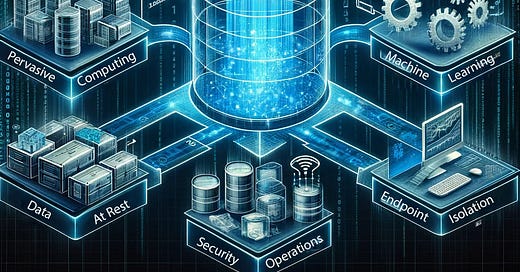Securing a modern data architecture framework?
Control what you can and mitigate what you can't
I ran across this excellent post on LinkedIn today. But it needed a bit of an explicit security statement. A note in each section would suffice, but I created a more comprehensive response to aid interested practitioners. Frameworks such as Least Privileged Access, Zero Trust, or Isolation are not explicitly listed here. They represent an overlay to specific needs and are not products you can purchase across an estate.
1) Collect:
a. Data Sensitivity and Privacy: Collecting data from various sources raises concerns about the sensitivity and privacy of the information. Ensuring sensitive data is identified, classified, and handled correctly.
b. Access Control: Unauthorized access to data during collection, especially from disparate sources, can lead to data breaches or siphoning.
c. Data Integrity: Ensuring the integrity of the data collected from multiple sources is essential to prevent tampering, corruption, or intentional poisoning.
d. API security in all its forms is required.
2) Ingest:
a. Data Encryption: Data must be encrypted during ingestion, especially in real-time, to protect it from intercepts and unauthorized access.
b. Secure Transmission: Data transmitted to the system needs secure channels (like TLS/SSL) to prevent eavesdropping or man-in-the-middle attacks.
c. Endpoint Security: The endpoints involved in data ingestion (like IoT devices) must be secured against vulnerabilities to prevent exploitation—Post Quantum-ready roots of trust and dedicated attestation device modules.
d. Many devices were created before new security measures were discovered and cannot be updated. Those need special consideration and isolation strategies, especially if the source node cannot set encryption.
3) Store:
a. Data at Rest Security: Ensuring data stored in data lakes, warehouses, or lakehouses is encrypted and securely managed to prevent unauthorized access.
b. Access Control and Authentication: Implementing strict access control policies and authentication mechanisms to ensure only authorized personnel can access or query the data.
c. Backup and Recovery: Ensuring robust backup and disaster recovery strategies are in place to protect against data loss or corruption.
d. Security can establish a discrete data-checking validation system that can be used to spot-check integrity through various techniques.
4) Compute:
a. Secure Computing Environments: Using isolation and least privileged architectures, ensure that data processing environments are safe from unauthorized access or tampering. Until we have telepathy, endpoints are the interface. They must have a secure root of trust.
b. Data Leakage: Prevent sensitive data from exposure during processing or in outputs, especially when dealing with external compute resources.
c. Compliance and Auditing: Ensuring that processing activities comply with relevant regulations and standards and maintaining logs for auditing and forensics.
d. In-flight model protection. Stream-based security models are used to preserve model integrity.
5) Consume:
a. Data Access Control: Ensuring that users and systems have appropriate levels of access to data, especially in BI tools and self-service analytics, to prevent unauthorized data exposure. Least privileged strategies at every level.
b. Data Sharing: Securely managing how data and insights are shared within and outside the organization to prevent unauthorized dissemination of sensitive information. API and abstraction security methods are essential here.
c. Integration Security involves ensuring that ML services or analytics results are integrated into other applications or processes without introducing vulnerabilities or exposing sensitive data.
Throughout all these stages, ongoing monitoring, threat detection, and response strategies are essential to quickly identify and mitigate potential security issues. Additionally, compliance with data protection regulations like GDPR or HIPAA, depending on the data's nature and usage, is crucial to avoid legal and reputational risks.




